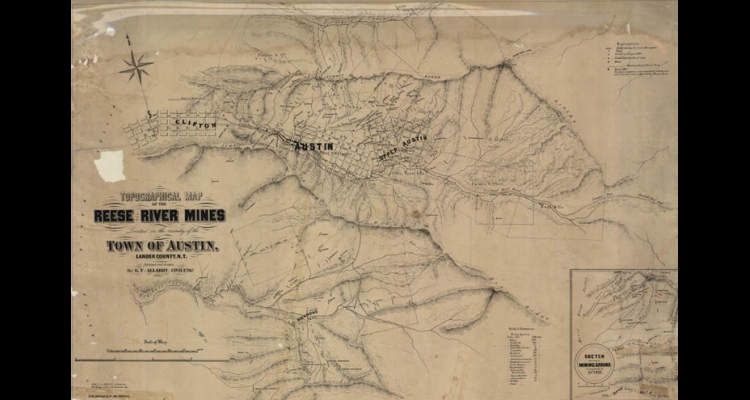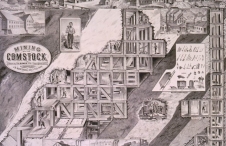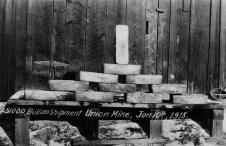Austin and the Reese River Mining District
In 1862, William Talcott discovered silver ore in Pony Canyon, a pass through central Nevada's Toiyabe Mountains. The strike attracted newcomers who founded Clifton below the new claims. David Buel then platted Austin up the canyon, naming his town for his partner Alvah Austin. Because of the rush, legislators created Lander County in December 1862.
Austin boomed in 1863. A temporarily depressed Virginia City even contributed its International Hotel, businessmen moving the substantial building the one hundred and seventy miles. Before the end of the year, Austin became the seat of Lander County.
Austin incorporated as a city in 1864, a year more memorable for a rivalry between Reuel Gridley and H. S. Herrick. Gridley, a southern sympathizer, bet Herrick a Democrat would win a local election. Gridley lost the wager, costing him a fifty-pound sack of flour, which he carried to Herrick with a band playing "Old John Brown." The men donated the flour to the Sanitary Commission, a precursor of the Red Cross. Gridley took bids for the sack, but the winner returned it to the commission, and it was auctioned off repeatedly. After Austin donated all it could, Gridley took his sack on the road. Between Nevada and California, the phenomenon raised roughly $175,000 to help the Civil War's wounded. What began as inconsequential gambling became one of Austin's more celebrated moments.
In 1865, the Manhattan Silver Mining Company began purchasing competing mines and mills, nearly monopolizing the local industry. Productivity, while consistent, remained modest. Occasional rushes to places such as Hamilton and Pioche drained Austin of its work force.
Profits peaked during the late 1860s and early 1870s. In 1872, miners pushed for unionization, demanding the Comstock standard minimum wage of four dollars per day. Labor action resulted in a few arrests, but the union was reasonably successful.
The Nevada Central Railroad reached Clifton in 1880, and a narrow gauge extended service up to Austin the following year. Despite the activity, Austin's mines continued to slump. Austin and its Reese River Mining District failed to become the next Virginia City. Nevertheless, Austin was a springboard for exploration and exploitation of regional mineral resources. Its network of communication, commerce, and finance encouraged the growth of Hamilton and Treasure Hill, Eureka, Belmont, Tuscarora, and many other mining towns.
Austin's newspaper, the Reese River Reveille, was an important voice for central Nevada with reporter Fred Hart writing in the tradition of Mark Twain and Dan De Quille. The mining town was also home to Emma Nevada Wixom, who won international acclaim as a nineteenth-century opera star.
The Manhattan Silver Mining Company disbanded in 1887. By 1890, the community had dwindled to a little more than one thousand. Limited mining continued into the twentieth century. A 1979 election transferred the county seat to Battle Mountain, stripping Austin of one of its remaining industries.
Today the Austin Historic District on Highway 50 survives as one of the nineteenth century's great centers of mining. Churches, businesses, residences, and even one of the nation's last Greek revival courthouses preserve vestiges of a former time.
Article Locations
Related Articles
Further Reading
None at this time.


